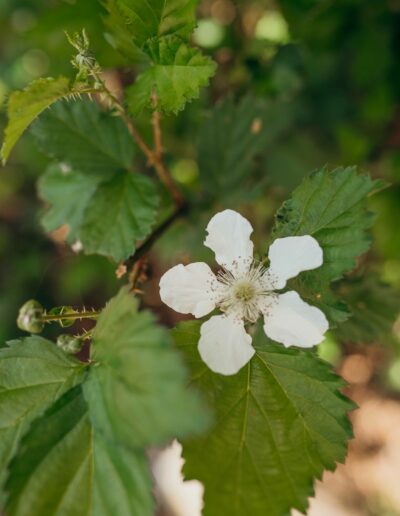Rubus
BromBEERE
Englische Bezeichnung: Black Berry
Spanische Bezeichnung: Mora
Familie
Rosengewächse (Rosaceae)
Verwendbare Teile:
Frucht & Blätter
Hauptbestandteile:
Vitamine: B-Vitamine, C, E, Beta-Carotin (Provitamin A)
Sekundäre Pflanzenstoffe: Antioxidantien (Flavonoide, Anthocyane)
Ernte-Hinweise:
Sobald die Früchte sehr dunkel ausgefärbt sind und sich leicht pflücken lassen, sind sie bereit zur Ernte.
Verwendung:
Marmelade, Mus, Saft oder Gelee, Salate, Garnieren, Backen
Was Brombeeren ihre dunkle Farbe gibt, sind tief dunkelrote Pflanzenfarbstoffe (Anthocyane), welche zahlreiche gesundheitsförderliche Vorteile mit sich bringen.
Die Blätter können z.B. als Tee zubereitet werden, sie wirken leicht zusammenziehend (adstringierend) und entzündungshemmend auf Haut und Schleimhäute sowie stopfend. Deshalb werden Brombeerblätter bei akutem unspezifischem Durchfall (z.B. bei Magen-Darm-Grippe, Reisedurchfall) sowie bei leichten Schleimhautentzündungen im Mund- und Rachenraum empfohlen.
Family
Rosaceae (rose family)
Usable parts:
Fruit & leaves
Main components:
Vitamins: B vitamins, C, E, beta-carotene (provitamin A)
Secondary plant substances: antioxidants (flavonoids, anthocyanins)
Harvesting guideline:
As soon as the fruits are very dark in colour and easy to pick, they are ready for harvesting.
Use:
Jam, puree, juice or jelly, salads, garnishing, baking
What gives blackberries their dark colour are deep dark red plant pigments (anthocyanins), which have numerous health benefits.
The leaves can be prepared as a tea, for example, and have a slightly astringent and anti-inflammatory effect on the skin and mucous membranes as well as having a constipating effect. Blackberry leaves are therefore recommended for acute non-specific diarrhoea (e.g. gastroenteritis, traveller’s diarrhoea) and for mild inflammation of the mucous membranes in the mouth and throat.
Familia
Rosáceas (familia de las rosáceas)
Partes utilizables:
Frutas y hojas
Componentes principales:
Vitaminas: Vitaminas B, C, E, betacaroteno (provitamina A)
Sustancias vegetales secundarias: antioxidantes (flavonoides, antocianinas)
Guía de cosecha:
En cuanto los frutos tienen un color muy oscuro y son fáciles de recoger, están listos para la cosecha.
Uso:
Mermelada, puré, zumo o jalea, ensaladas, guarnición, repostería







































